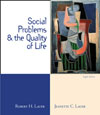CHAPTER 15 War Extent of the Problem of War (pp. 514-515) The prevalence of war is demonstrated by the fact that an international war
was being fought in 126 of the 150 years between 1816 and 1965. In a sample
of ninety-three international wars, there were over twenty-nine million deaths
of military personnel, and countless additional civilian deaths. We live in
a world that is never free of war. War and the Quality of Life (pp. 516-531) War is violence on an international level. Human destruction reaches a peak
in war. Since the start of our own Civil War, at least 641,000 Americans have
perished in battles alone, and millions more have either been wounded or perished
in noncombat incidents. Human destruction in war has increased enormously because
of advancements in the technology of war. More people have died from war in
the 20th century than in any other century. Even without holocausts,
war diminishes the quality of life in many ways: death, injury, disruption,
dehumanization, anxiety, mistrust, environmental destruction, economic waste,
and loss of liberty. The consequences of conventional war are pale in contrast
to the prospect of nuclear winter as a probable outcome of a nuclear war. Military
spending in the United States has declined somewhat since the late 1980s, but
by 1999, defense spending still accounted for 16 percent of all federal spending
and 3.2 percent of the gross domestic product. Clearly, militarism is a problem
for the entire world. War always poses a threat to civil liberties. Contributing Factors (pp. 531-536) We should find hope in the knowledge that some societies, such as the Hopi
Indians, have no notion of organized warfare. War, like aggression and violence,
is linked with cultural values and patterns and thus should be subject to change.
War is a highly complex phenomenon related to a combination of structural and
social psychological factors, including economics, politics, attitudes, and
ideology. The authors point to the military-industrial complex as one very important
component in the politics of war and peace. The American need to "be a winner"
has facilitated our involvement in various conflicts, including the more recent
skirmishes in Grenada, Panama, and the Persian Gulf. What Is to Be Done? (pp. 537-538) Clearly, there are no simple solutions to the problems of war on any scale-small,
medium, or holocaust. One important step, however, would be to reverse the patterns
of increasing militarism and investment in military resources. Efforts by nations
to engage in tension reduction through visible reciprocal action, such as putting
brakes on the arms race, seem to involve minimum risk to the major world powers. |



 2002 McGraw-Hill Higher Education
2002 McGraw-Hill Higher Education